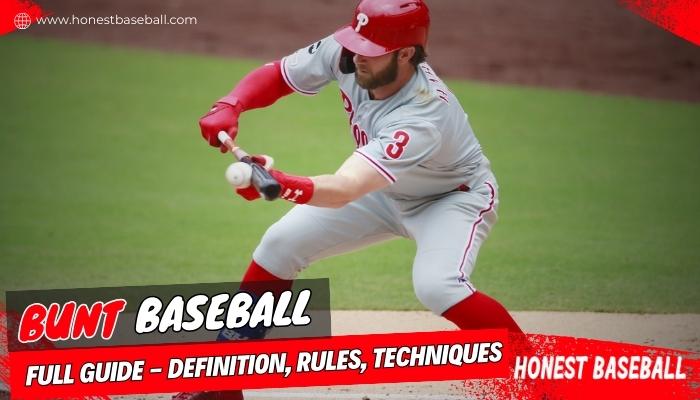Did you know that in MLB, bunts account for just 2% of all hits? Yet, they are an essential part of the game. Bunting refers to the light tap shots usually holding the ball within the infield zone with an aim to advance bases.
However, after 200+ years of evolution, I found the trend of bunt baseball is slowly declining. It is a deemed hope that we will ever see players like Masahiro Kawai or Eddie Collins with 500+ bunts.
But why is it less popularizing in the last decades? Should a beginner in baseball try learning this bunting strategy, when or how to bunt? In this guide, you will get all the answers.
Key Takeaways
- MLB has specific rules that govern fouls, double hits, and pop-ups when bunting, differing from regulations for normal batting.
- Bunting evolved from early experiments in the 1800s to a pivotal strategic technique before waning in popularity again in the modern power-hitting era.
- Certain game situations like close scores late, runners on base, and facing dominant pitching make bunting a strategic choice worth considering.
- Dickey Pearce and Pro. Bassler is one of a few first-liners who helped to make the batting technique popular among other players.
- The top MLB bunters of 2023 include Brett Phillips, Joey Meneses, and Tim Locastro who have honed this specialized skill.
What Is Bunt Baseball?
The bunt in baseball is a strategic play where the batter gently taps the ball into the infield. Though often used to advance runners or reach base safely, the bunt can serve other purposes too.
Skilled bunting disrupts the defense’s positioning and timing. Executed well, it is an artful play requiring precision and game awareness.
Bunting provides some benefits:
- In key situations, a timely bunt can shift momentum.
- It forces hurried infielders into difficult split-second decisions, potentially leading to mistakes.
Famous bunts demonstrate the power of this crafty play. For instance, San Francisco’s Brett Butler’s expertly placed bunt on August 31, 1990, sparked a Giants comeback. Though underutilized today, the bunt retains strategic value for catcher teams off guard.
MLB Baseball Bunt Rules
The art of bunting in baseball has unique rules that govern foul bunts and double hits. Specifically, fouls count as strikes, potentially leading to a strikeout on the third.
Accidental double hits also result in a strike. However, bunts popped straight up are exempt from the infield fly rule.
| Rule | Outcome | Explanation |
| Foul Bunt | Strike | If not caught in flight and it is a third strike, it results in a strikeout. |
| Double Hit | Strike | If a batter bunts and the bat hits the ball again, even by accident, it is a dead ball and a strike. |
| Bunt Pop-up | No Infield Fly | Unlike other situations, the infield fly rule isn’t applied to bunts popped up in the air. |
Bunt Scoring
- The official scoring system determines whether a play is scored as a bunt or an ordinary at-bat.
- The scorer considers the batter’s intent and the result of the play when making this determination.
Types of Bunt Technique: Sacrifice, Bunting for a Base Hit, Drag, and Squeeze
There are several bunt techniques you can see in baseball:
- Sacrifice Bunt
- Bunting for a Base Hit
- Drag Bunt
- Squeeze Bunt
- Swinging bunt
Each has its particular time and place within a game, depending on the situation and your goals at the plate.
Sacrifice Bunt: Intentional Hit to Advance a Runner
The sacrifice bunt is one of the common bunting methods. Following the strategy a batter deliberately bunts the ball to advance a baserunner, mostly at the cost of their own out.
I am sure, now, you got the idea behind the naming. In close games with low runs, the sacrifice bunt becomes a wise movement.
“Trading an out for positioning works best with weaker hitters unlikely to get a hit. I feel pity for them, but that is how team strategy works.”
Characteristics:
- Batters sacrifice their own out to move a teammate
- Best for weaker hitters unlikely to get a base hit
- Sacrifice bunt does not count as an official at-bat
- Does not negatively impact the batter’s batting average
Goals:
- Used to advance a runner from 1st to 2nd base typically
- Also can move a runner from 2nd to 3rd or score from 3rd
Bunting for a Base Hit: For Reaching the Base Safely
It is another offensive play where the batter attempts to safely reach base by bunting the ball, rather than sacrificing their out to advance a runner.
The batter tries to surprise the defense by masking their intent and placing the ball where fielders cannot reach it quickly enough.
Characteristics:
- Batter holds bunt until the last moment to surprise fielders
- Batter sprints to first, trying to outrun the defender
- Rarely results in extra-base hits like doubles
Goals:
- To ensure the batter safely reach base, not to advance runners
Drag Bunt: Tap and Run for the First Base
The drag bunt is a type of bunt where the batter begins running to first base as they are bunting the ball.
It allows the batter to get a head start towards first, capitalizing on those extra seconds to try to beat out the bunt for a hit.
Characteristics:
- Utilized more by left-handed hitters
- The batter starts running as they are bunting
- Does not allow the batter to square up fully before bunting
- Bat may only be gripped with one hand during drag bunt
Goals:
- Catch infielders off guard and beat out the bunt for a hit
- Take advantage of the left-handed hitter’s positioning closer to first base
Squeeze Bunt: For Advancing Third Base Runner
The squeeze bunt is another advanced technique where the batter bunts to allow a runner on third base to score.
In general, the batter attempts to place the bunt in a spot that makes it difficult for fielders to prevent the runner from scoring.
Characteristics:
- Runner positioned on third base
- Batter bunts to enable runner to score
Goals:
- Ensure bunt placement makes it hard for fielders to prevent run
- Advance runner from third base to home plate to score a run
- Successful squeeze bunts can shift the momentum of tight games
Swinging Bunt: Resembles But Not a True Bunt
A swinging bunt is when a batter does not fully swing but makes minimal contact, tapping the ball only a short distance into play.
It resembles a bunt but occurs during a checked or partial swing rather than via a deliberate bunt technique.
Characteristics:
- Occurs on a checked or partial swing
- The bat makes minimal contact with the ball
- Ball rolls only a short distance into play
- A “slug” swinging bunt aims for hard contact to confuse defense
Goals:
- Surprise the defense who may be expecting a bunt
- Catch infielders off-guard by not fully swinging
Situations ONLY When You Should Bunt
The strategy of bunting depends greatly on the game situation. You should only execute a bunt if you are in any of the below states:
- Late Innings: Late innings in close games, bunting can advance or score crucial runs
- Runners on Bases: Runners on 1st/2nd or 3rd with < 2 outs creates bunt opportunities
- Skilled Batters: Go for a bunt only if you or the batter is a skilled bunter
- Low Score Difference: With small score differences, trading outs for runs is more justifiable
- To Analyze Lineup: Some bunters only execute in order to identify pitcher dominance and team strategy. Defensive shifts/positions influence bunting choice and placement
How to Bunt in Baseball as a Beginner?
As a new player if you want to learn the art of bunting, having a simple step-by-step guide can help build your skills. Mastering the bunt strategy will significantly improve your bunt success rate.
“I did an assessment on 200 baseball students in my academy in the last 12 months where I found surprising statistics after evaluating their bunting performance. “
For beginners, the success rate can vary based on the execution difficulty and bunting types. Check out the below chart for reference.
| Bunt Technique | Execution Difficulty | Bunt Success Rate |
| Sacrifice Bunt | Moderate to Easy | High |
| Bunting for a Base Hit | Moderate to Difficult | Moderate to High |
| Drag Bunt | Moderate to Difficult | Moderate to High |
| Squeeze Bunt | Moderate to Easy | High |
| Swinging Bunt | Moderate to Difficult | Low to Moderate |
Anyway, don’t get frustrated before starting. Follow these key steps to increase your bunt success rate:
Step 1: Get into the Proper Batting Stance

Stand sideways with your dominant hand above the non-dominant hand on the bat. Have your feet shoulder-width apart and knees slightly bent. Keep your weight balanced, don’t lean too far forward or back. Relax your grip and focus on the pitcher.
Step 2: Pivot as the Pitch is Thrown
As the pitcher begins his throwing motion, pivot your front foot towards the pitcher and turn your shoulders. I remember being so anxious when first trying this, I pivoted way too early and almost spun myself into the ground!
Step 3: Slide Top Hand Up the Barrel
Grip the barrel tightly with your top hand while sliding your bottom hand a few inches down. Keep that bottom thumb wrapped under the handle. This gives you control when bunting.
Step 4: Square Your Body to the Ball
Rotate your shoulders and hips to square up fully to the ball as it approaches the plate. Resist striding forward. This sets you up for solid contact.
Step 5: Bend Your Knees to Get Low
Drop down into a deep athletic stance, bending those knees. Getting low allows you to track and adjust to different pitch heights.
Step 6: Angle the Bat Properly
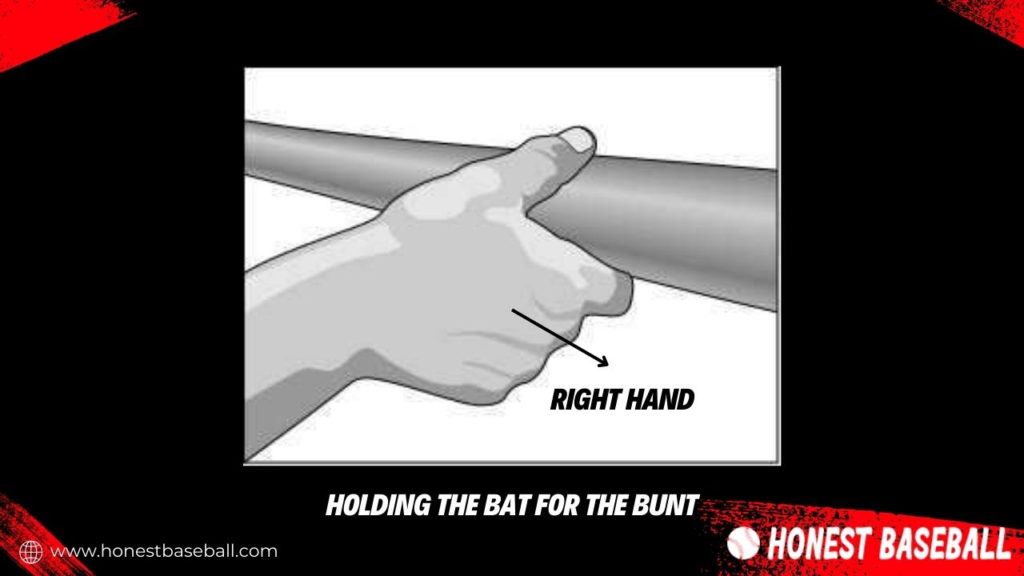
Tilt the bat between a 30-45 degree angle. This lets you direct the bunt better. I prefer a 45-degree angle to bunt towards the first base side.
Step 7: Meet the Ball with the Bat
As the ball reaches the plate, let it meet the bat gently. Don’t swing hard. Imagine tapping an egg on the barrel – delicate touch.
Step 8: Sprint Towards First
Drop the bat immediately and explode out of the box! Bust it down the line as fast as you can – every step counts when trying to beat out a bunt.
Keep practicing the mechanics until bunting feels natural. You will be dropping down surprise bunt singles in no time!
Best 3-Step Drill for Improving Bunt Execution
As a baseball beginner looking to improve your bunting skills, this simple 3-step drill can help refine your technique. I learned about this drill from Coach McCrearyin in 2012.
Step 1: Mimic Proper Bunting Position
Use a glove opposite your hitting hand and get into a bunting stance. Outstretch your glove over the plate as if fielding a bunt.
Pretend you’re holding a bat and practice angling it to catch balls in the glove.
Do this 10 times, working on your form. This mimics real bunting positioning and movement.
Step 2: Place Barrel in Glove
Now, square up and place the bat barrel inside your outstretched glove. This trains you to use the bat as an extension of your hand when bunting.
As you catch balls with the bat in your glove, you learn to guide and control bunts, not just hit them randomly.
Step 3: Refine Technique Without Glove
Finally, lose the glove and focus on using the bat with precision. Pay attention to your swing mechanics. Do eye-level alignment drills for low pitches.
Emphasize catching balls on the bat sweet spot, not jabbing. Lefties should learn bunting motions tailored to them. Refine control and avoid mistakes.
Advanced Tips for Fielding a Bunt in Baseball
You will get better at fielding a bunt in baseball with practice and understanding the types of bunts.
Also, it is essential to become familiar with bunt baseball techniques, which include a direct line and body position, a scooping action, and specific strategies for different types of bunts.
The Key to Bunt Fielding Tips Is Communication
As the catcher, let your infielders know you have got the play. Keep your body low and your knees bent, maintaining balance to make that crucial play.
Your scooping action must be fluid, bringing the ball towards your chest to maintain control.
Understanding the Types Of Bunts Is Integral
If it is down the first base line, take a direct line toward the ball. Clear the path for potential runners with a jab step toward the inside part of the infield.
For a bunt down the third base line, step over the ball, get your chest over it, make a strong throw, and set your feet towards first base.
Portland Baseball Club Bunt Defense Secret
The Portland Baseball Club coach suggests a deep analytical fielding guide for bunting. This is a real gem. I am breaking down the whole concept to make it easy to understand.
Situation 1: Regular – No Runners/Runner on 1B
In a typical situation with no runners on base or only a runner on first base, fielders should be in their standard positions.
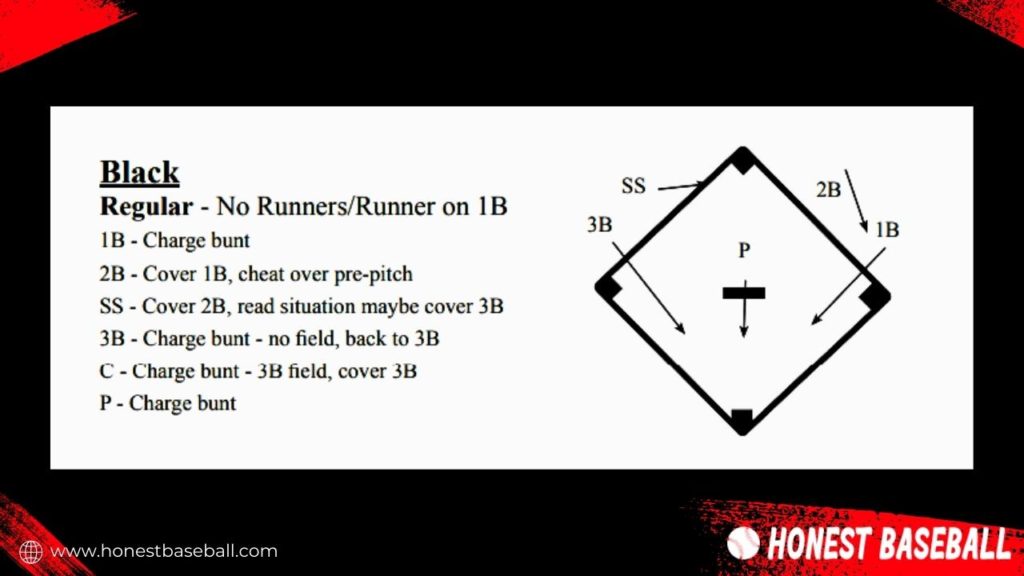
- 1B – Charge bunt: The first baseman should move closer to home plate (charge) when the batter attempts a bunt.
- 2B – Cover 1B, cheat over pre-pitch: The second baseman should cover first base to assist if the first baseman charges. They can also shift slightly towards the first base before the pitch.
- SS – Cover 2B, read situation maybe cover 3B: The shortstop should be ready to cover second base if needed. Depending on the situation, they might also be prepared to cover third base.
- 3B – Charge bunt – no field, back to 3B: The third baseman should charge towards home plate when the batter bunts but should be ready to return to their position if the ball isn’t bunted.
- C – Charge bunt – 3B field, cover 3B: The catcher should charge towards home plate when the batter bunts. If the third baseman fields the ball, the catcher should cover third base.
- P – Charge bunt: The pitcher should also charge toward home plate when the batter attempts a bunt.
Situation 2: Lead Runner – Runner on 2B
In a situation with a lead runner on the second base, fielders should follow the below movements.
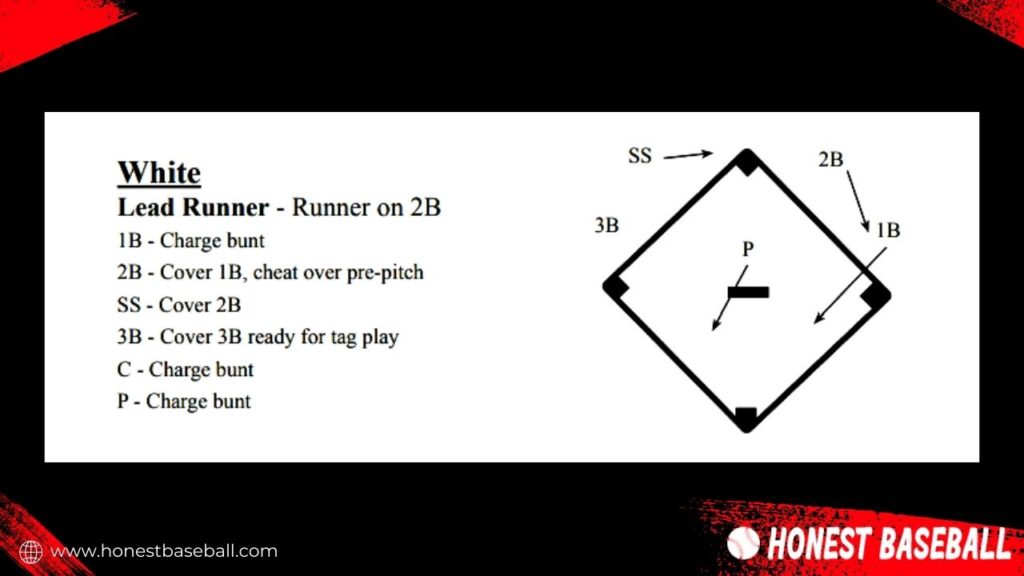
- 1B – Charge bunt: The first baseman moves closer to home plate (charges) when the batter attempts a bunt.
- 2B – Cover 1B, cheat over pre-pitch: The second baseman covers first base to assist the first baseman and may shift slightly towards first base before the pitch.
- SS – Cover 2B: The shortstop is responsible for covering second base.
- 3B – Cover 3B ready for tag play: The third baseman covers the third base and is prepared for a tag play if needed.
- C – Charge bunt: The catcher moves towards home plate when the batter bunts.
- P – Charge bunt: The pitcher also charges towards home plate to be ready for fielding.
Situation 3: Wheel Play – Runner on 2B
In the wheel play for baseball with a runner on second base, fielders are positioned as follows:
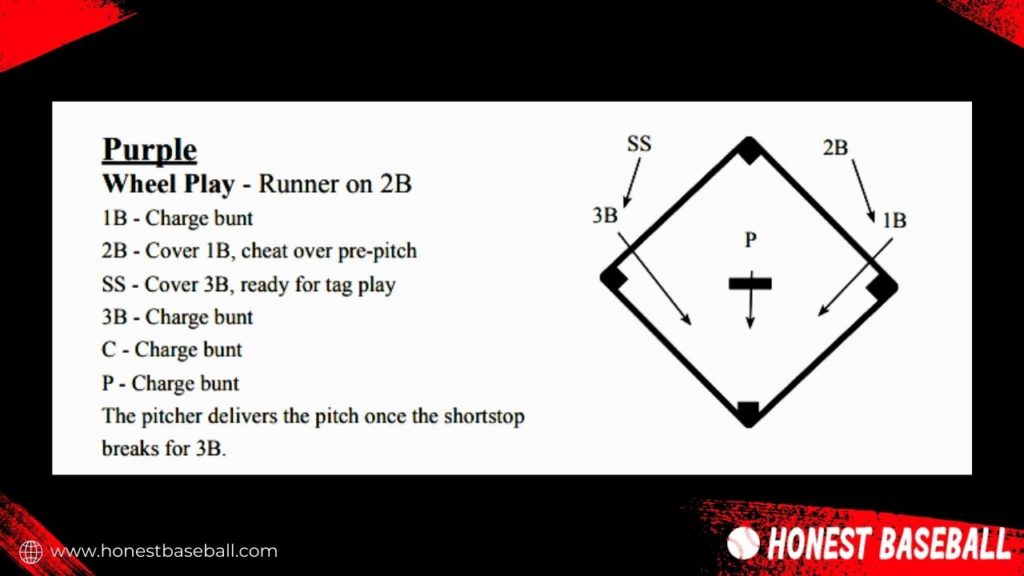
- 1B – Charge bunt: The first baseman moves closer to home plate (charges) when the batter attempts a bunt.
- 2B – Cover 1B, cheat over pre-pitch: The second baseman covers first base to assist the first baseman and may shift slightly towards first base before the pitch.
- SS – Cover 3B, ready for tag play: The shortstop is responsible for covering third base and is prepared for a potential tag play.
- 3B – Charge bunt: The third baseman moves closer to home plate (charges) when the batter attempts a bunt.
- C – Charge bunt: The catcher moves towards home plate when the batter bunts.
- P – Charge bunt: The pitcher also charges towards home plate to be ready for fielding.
Baseball Bunt History (1800s to 2000s)
In your exploration of bunt baseball history, you’ll uncover a wealth of information about its evolution over the course of more than 200 years.
1864
An early reference to a bunt-like hit emerged during a game between the junior teams of the Excelsior of Brooklyn and Enterprise clubs.
Prof. Bassler of the Enterprise squad employed a unique hitting technique, deliberately making the ball drop near the home base.
This marks one of the initial instances of a bunt-like maneuver in baseball.
Late 1800s
Dickey Pearce, an esteemed figure in early baseball, is believed to have honed the technique of bunting.
He used his ‘tricky hit,’ taking advantage of rules that permitted a ball to roll foul yet still count as a hit.
Despite these developments, bunting remained relatively uncommon during this era.
1880s
The bunting technique began to gain popularity in baseball, though it has not yet solidified as an established component of strategic play.
1900s to 1960s
During the Dead-Ball Era of the early 1900s and the 1960s, characterized by pitching dominance, bunting emerged as a pivotal offensive tool.
1990s to 2000s
The era was marked by hitting dominance, questions arose regarding the utility of bunting.
Teams adhering to the principles of the “Moneyball” philosophy, such as the Oakland Athletics, Boston Red Sox, and the 2004–2005 Los Angeles Dodgers, tend to avoid using the sacrifice bunt.
2000s
As the 20th century unfolds, the bunt gradually garners recognition as a valuable strategic move in the sport.
2000s to 2002
Los Angeles Angels, known as pioneers of “small ball” tactics, frequently employed bunting to overcome power-hitting opponents.
List of MLB Players with the Highest Bunt Attributes 2023
Diving into the list of MLB players with the highest bunt attributes, you are about to discover those who have mastered this strategic skill.
The main evaluation was done by “MLB The Show 23“, which listed 100 baseball players. Let’s take a look at the top 30 of them.
Note:
- Bunt scores represent players’ ratings between 0-100.
- OR or Overall Ratings represents players’ scores between 0-100.
- PG or Potential Grade represents players’ score between A-C grading.
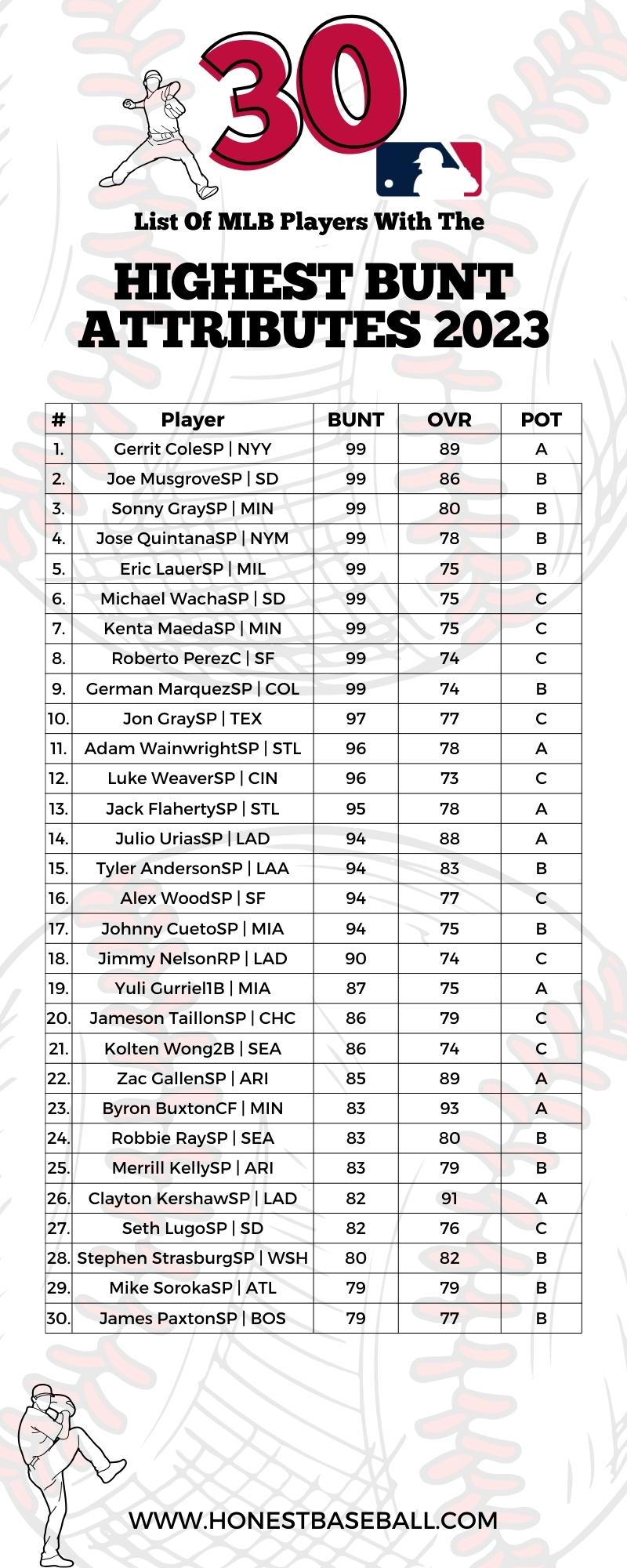
Frequently Asked Questions
Who has the most bunts in their career?
There is a misconception that Eddie Collins stands in terms of the most career bunts given his record of 512 successful bunts. However, according to the “Guinness Book of World Records,” the title goes to Japanese baseball player Masahiro Kawai with 514 sacrifice bunts.
Why do MLB players not bunt anymore?
MLB players don’t bunt anymore due to the focus on power-hitting, but it is also because pitching has drastically improved. The reasons for the decline in bunting are multifaceted.
Today’s pitchers are far superior to those from a historical perspective. Their skill set makes scoring a single tougher than ever, rendering bunting less effective.
Is bunting bad in baseball?
In baseball, bunting is not always ineffective, but it can lower your odds of winning in certain scenarios. Bunting strategy varies across different baseball leagues, and its effectiveness is heavily influenced by a variety of factors.
It can advance runners and create scoring opportunities. However, it often sacrifices an out, which could be detrimental.
What is a bunt attempt?
You might think a bunt attempt is simply tapping the ball into play, but the fun fact is it is also considered an attempt if you are just holding the bat in the strike zone.
What percent of bunts are hits?
According to the Houston Astros analysis, the success rate of bunts turning into hits is roughly 70-80%. When the bunts aren’t successful, the chance of scoring 0 runs surges by about 20%.
When is a bunt a strike?
A bunt is always a strike if it is foul and not caught mid-air. This rule is unique to bunting, as other foul balls are not considered strikes if they are not a third strike.
Who has the most bunts in a single season in MLB history?
Brett Butler holds the record for the most bunts in a single MLB season with an impressive 29 bunt hits in 1992. The success rate was 57%.
Wrapping Up
That was quite a long tipping session. But it is worth the team when it comes to sports knowledge, especially something crucial like the bunt baseball, which has more than 200 years of legacy.
Yeah, I know the trend is declining day by day, but baseball learners should learn every possible playing technique to sharpen their skills, even more. So, keep practicing.
Check out more insightful baseball knowledge guide
What Is Chin Music In Baseball
What Is A Perfect Game In Baseball

Hello everyone. My name is Jason Butler, and I live in California, America. I was a professional AAA Minor League Baseball player. I lost my chance of playing MLB for injury issues, but I did not lose my love for baseball. I attended the coaching training program and am now working as a coach in a small school in San Diego.
I always love to share my experience and knowledge if that can help you. Play baseball, and stay fit.
